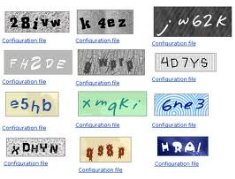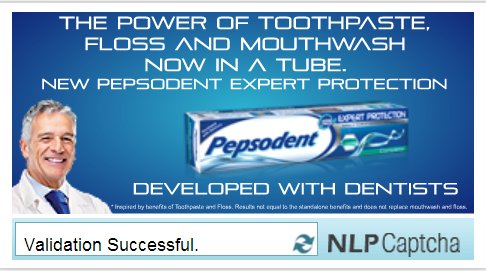CAPTCHA
s have become a common security measure used by websites to prevent
capture of information or creation of service requests on the web by
use of robotic software. It is a "Challenge-Response" test to identify
if the person at the other end of the computer is a human being or not.
According to Wikipedia, The term "CAPTCHA" was coined in 2000 by Luis
von Ahn, Manuel Blum, Nicholas J. Hopper, and John Langford (all of
Carnegie Mellon University). It is an acronym based on the word
"capture" and standing for "Completely Automated Public Turing test to
tell Computers and Humans Apart".
Today I came across the following innovative CAPTCHA on the Hindu page which I want to share here.
As we know the initial
CAPTCHAs (First generation) were an attempt to present some
letters or numbers on a background image so that the charecters cannot
be recognized by a software.

This was followed by other types of Captcha (Second generation)
along with audio play of the charecters for the physically challenged
persons.
Note that these Captcha boxes were meant purely for the function of
asking the user to do some thing with the key board which the
auotomated systems could not do.
Soon marketing persons recognized that these Captch boxes had to have a
close attention of a human being and hence were exellent for
advertisements.
The exploitation of the marketing potential of the Captch boxes is used
by Google in the form of a branded Captcha box. (Third genertion)
The Fourth generation Captcha was found in the type of Catcha shown
below where a thrid party ad appeared as a part of the Captch box.
The latest form form of Captcha which we can recognize as the fifth
generation of Captcha is indicated in the beginning used by Hindu
and served by NLP Capcha.
The innovative feture in this ad is that the user is made to drag
theree picture elements down to the bland picture of a
toothpaste box and when this is done the picture transforms into a
branded toothpaste picture as shown below.

What is innovative
about this Captch design is that the user is made to focus on the USPs
of the product advertised and a visual indication of how they combine
into the product is demonstrated. Psychologically this has the
potential to leave a lasting impression on the minds of he user and
hence makes a great advertising creativity. This is the first time I
have observed this type of Captcha.
As a person who once worked in the Internet advertising area in the
year prior to 2000, it appears that the advertisers of 2012 have caught
onto the true spirit of advertising on the internet media.
As compared to this, some advertisers who use video ads that consumer
bandwidth at the expense of the user and ads that forcefully block the
reading content create such dissonance in the minds of the internet
user that they may start hating the product advertised.
I hope advertisers start recognizing this difference in the "Creativity".
My hearty congratulations to the creative person who designed the NLP
captcha of Pepsodent. This ad deserves commendation by the advertsing
community for starting a new trend in "Internet Ad Creativity".
A point of caution is however to be indicated. From the security
perspective, this system will not be advisable for a fixed term based
ad exposure on a webpage. It appears that Hindu has implemented the ad
in such a mode.

